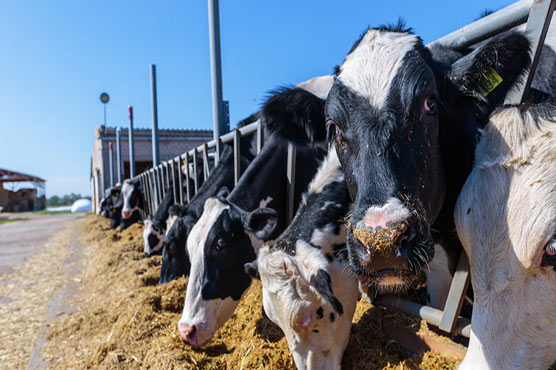Gene-edited livestock carry huge promise but major pitfalls

Buri eventually sired six calves, all of them raised on Davis's research farm.
DAVIS, United States (AFP) – If American researchers have successfully employed new gene-editing techniques to develop hornless dairy cattle and piglets born castrated -- a seeming boon to farmers and ranchers -- they are still struggling to move these animals from stable to table.
A team at the University of California, Davis led by animal geneticist Alison Van Eenennaam has been working on the hornless cattle challenge.
Ranchers and farmers often have to remove animals’ horns -- a painful procedure -- to prevent them from goring one another or harming their human handlers.
But certain beef-cattle breeds like Angus are born without horns.
So once scientists identified the gene responsible for the absence of horns, bioengineers with Minnesota-based Recombinetics used molecular "scissors" to alter the DNA in cells from a Holstein, a popular dairy-cattle breed.
While the genetic "scissors" called CRISPR-Cas9 are better-known, Recombinetics used a tool called TALENs (Transcription Activator-Like Effector Nuclease). The result: the 2015 birth of hornless bulls Spotigy and Buri.
Buri eventually sired six calves, all of them raised on Davis’s research farm.
A surprise discovery
For confirmation that flesh from these animals would be suitable for human consumption, Van Eenennaam consulted with the US Food and Drug Administration (FDA).
Almost by chance, scientists there discovered an unexpected genetic modification while working on a related project using published data on the bulls’ genome.
"We saw the intended edited mutation, and I was just checking the final boxes before I moved on," said Alexis Norris, a bioinformatician with the FDA’s Center for Veterinary Medicine.
"And that’s when I noticed that the plasmid sequence was present in the cows, and it was not expected.
"It was really a shock."
The plasmid sequence, a DNA fragment used to alter a targeted gene, was supposed to disappear on its own, and Recombinetics -- which now uses a different technique in conceiving hornless cattle -- had not checked for its presence.
The fact that a foreign fragment had become inserted into the DNA is not necessarily dangerous for either the animal or consumers, the FDA says.
But "if there is an unintended alteration, does that impact the composition of the food?" asked Heather Lombardi, the FDA’s director of animal bioengineering and cellular therapies. "Would it have any impact on something like allergenicity or toxicity?"
In any case, the agency says the discovery underscores the importance of maintaining close surveillance over the use of gene-editing tools on animals at a time when advocates of the technology are pressing for less rigorous oversight.
For those advocates, animals whose genes have been edited by cutting and inserting DNA fragments are different from genetically modified organisms (GMOs) involving the insertion of foreign genetic elements.
But the European Court of Justice decided in a closely watched 2018 case that organisms resulting from gene editing should be considered as GMOs -- requiring the same lengthy approval processes.
Unknown consequences
Following the discovery of the unexpected genetic material, Van Eenennaam decided she had no choice but to order the incineration of the five gene-edited males. Keeping them alive would have been far too expensive, she said.
The lone female, Princess, will likewise be euthanized and incinerated once she has given birth and provided milk to be analyzed.
"Gene editing is where GMO was 20 years ago," Van Eenennaam said. "Activists are beating the drums saying something is going to have unknown consequences, Europe comes out with the precautionary principles.
"The only thing different is that South America is saying no, and Africa is starting to flex its muscles," while China ramps up its gene-editing research, she said.
There are many promising applications for gene editing, Van Eenennaam said: developing more heat-resistant livestock -- invaluable in a warming world -- or pigs resistant to African swine fever, which has devastated herds in China.
The Australian-born Van Eenennaam, who spent time working on a Texas cattle ranch during her undergraduate days, is now experimenting with using the SRY gene, which inhibits the development of female characteristics, to create entirely male herds.
After several failed attempts, a "carrier" cow was finally successfully inseminated in June and should give birth in March 2020.
The goal is to be able to develop beef herds composed entirely of males -- who carry more meat on their bones -- or female-only herds of dairy cows, as well as female-only flocks of chickens.
But such ideas can be a hard sell.
Developing animals with resistance to diseases that would not exist outside of intensely crowded, factory-farming conditions might encourage further abuses, said Katherine Roe of the animal-protection group PETA.
"A lot of the alterations they are making in the interest of welfare will give excuses to farmers to keep them in horrific conditions," Roe said.
And Thomas Gremillion of the Consumer Federation of America stressed that "even if food products from GE animals are rigorously tested and approved as safe, many Americans find the genetic engineering of animals to be offensive and do not wish to consume products made from those animals."

